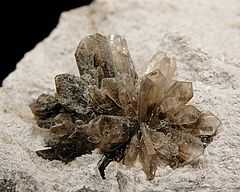Howlite
| Howlite | |
|---|---|
 | |
| General | |
| Category | Inoborates |
| Formula (repeating unit) | Ca2B5SiO9(OH)5 |
| Strunz classification | 06.CB.20 |
| Crystal symmetry |
Monoclinic prismatic H-M symbol: (2/m) Space group: P 21/c |
| Unit cell | a = 12.82 Å, b = 9.351(1) Å, c = 8.608(2) Å; β = 104.84(2)°; Z=4 |
| Identification | |
| Color | White, colorless |
| Crystal habit | Massive to nodular, occurs as tabular prisms flattened parallel to [100] |
| Crystal system | Monoclinic |
| Cleavage | None |
| Fracture | Conchoidal, uneven |
| Mohs scale hardness | 3.5 |
| Luster | Subvitreous, glimmering |
| Streak | white |
| Diaphaneity | Translucent |
| Specific gravity | 2.53 - 2.59 |
| Optical properties | Biaxial (-) |
| Refractive index | nα = 1.583 - 1.586 nβ = 1.596 - 1.598 nγ = 1.600 |
| Birefringence | δ = 0.017 |
| 2V angle | 73° |
| References | [1][2][3] |
Howlite, a calcium borosilicate hydroxide (Ca2B5SiO9(OH)5), is a borate mineral found in evaporite deposits.[4] Howlite was discovered near Windsor, Nova Scotia in 1868 by Henry How (1828–1879), a Canadian chemist, geologist, and mineralogist.[5][6] How was alerted to the unknown mineral by miners in a gypsum quarry, who found it to be a nuisance. He called the new mineral silico-boro-calcite; it was given the name howlite by James Dwight Dana shortly thereafter.
The most common form of howlite is irregular nodules, sometimes resembling cauliflower. Crystals of howlite are rare, having been found in only a couple localities worldwide. Crystals were first reported from Tick Canyon,[7] California,[8] and later at Iona, Nova Scotia. Crystals reach a maximum size of about 1 cm.[1] The nodules are white with fine grey or black veins in an erratic, often web-like pattern, opaque with a sub-vitreous lustre. The crystals at Iona are colorless, white or brown and are often translucent or transparent.
Its structure is monoclinic with a Mohs hardness of 3.5 and lacks regular cleavage. Crystals are prismatic and flattened on {100}.[8] The crystals from Tick Canyon are elongated along the 010 axis, while those from Iona are elongated along the 001 axis.
Howlite is commonly used to make decorative objects such as small carvings or jewelry components. Because of its porous texture, howlite can be easily dyed to imitate other minerals, especially turquoise because of the superficial similarity of the veining patterns. The dyed howlite (or magnesite) is marketed as turquenite.[9] Howlite is also sold in its natural state, sometimes under the misleading trade names of "white turquoise" or "white buffalo turquoise," or the derived name "white buffalo stone."
Gallery
-

Howlite, as collected, southern California.
-

A polished mass showing veining.
-

Form of howlite crystals from Iona, Nova Scotia.
-

Form of howlite crystals from Tick Canyon, California.
-

Howlite artificially colored in blue, and sold under the name turquenite.
See also
References
- ↑ 1.0 1.1 Handbook of Mineralogy
- ↑ Howlite on Mindat
- ↑ Howlite on Webmineral
- ↑ Howlite at Mineral Galleries
- ↑ H. How, "Contributions to the Mineralogy of Nova Scotia, Pt. III, Borates and Other Minerals in Anhydrite and Gypsum," Philosophical Magazine, January 1868
- ↑ Ramik, Robert A., "Lost and Found: one of Canada's earliest type mineral localities", The 32nd Rochester Mineralogical Symposium, Program and abstracts, Rochester, New York, April 14–17, 2005.
- ↑ 34°28′52″N 118°21′57″W / 34.48111°N 118.36583°W
- ↑ 8.0 8.1 Murdoch, J., "Crystallography and X-ray measurement of howlite from California", American Mineralogist, 42, 521-524, 1957.
- ↑ turquenite on Mindat
| Wikimedia Commons has media related to Howlite. |